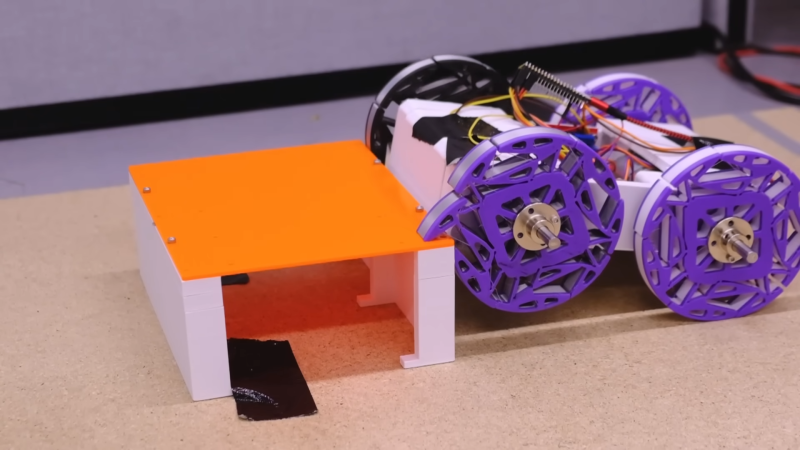Wheels do a great job at rolling over all kinds of terrain, particularly if you pair them with compliant tires. However, they’re not perfect, and can get stumbled by things like large vertical steps. Enter the PaTS-Wheel — a compliant mechanism that can tackle such obstacles with ease.
The PaTS-Wheel takes advantage of printable flexural hinges. Under regular conditions, it exists as a simple round wheel. However, when presented with a step obstacle, its individual segments can bend and flex to grab on to the step and hoist the vehicle up. It all happens passively as a result of the wheel’s structure, no actuators or control system are needed to achieve this action.
The video below does a great job of explaining the concept in raw engineering terms, as well as showing it in action. If you really want to drill down though, dive into the research paper. The design outperformed smooth wheels and whegs in climbing ability, and was able to match smooth wheels in simple tests of flat ground power consumption. The results are very impressive.
We’ve seen other transforming wheels before, like these wheg-like constructions, but nothing so passive and elegant as these. Video after the break.















I’d had a similar thought a while ago, nice to see it tested, and in this case it working better than I’d expected it to.
Though I do wonder if it will really prove fit for much use in the real world – all those gaps that must remain reasonably empty for the flextures to flex could very much limit its value in very clingy mud type terrain, and all those openings offer up lots of potential for loose broken terrain full of Lego, loose cables, rocks and twigs to jam the wheels rotation entirely.
Also looks like the movement to pop the claw out is quite a large deformation – so I expect the lifespan of these wheels isn’t huge. Plus just how well it will scale up and down and deal with higher loads is questionable as well…
Still really cool.
it makes me think of cat’s claws, like when you press on their paw pad and their claw just slides right out
maybe we can lean into that biomimicry and start creating flexible closures and ‘immune systems’ for robots
Reminds me of this
https://youtube.com/watch?v=Afofc_Jt86s
Came to say this
Same.
I had one of those when I was little. It was an awesome toy and actually worked well as advertised. Each wheel hub had a selector switch where you could select no claws, always claws, or torque claws. After watching that I even remember the commercial theme song.
Thanks for that.
Well that’s definitely interesting.
The robotics applications I’ve worked on have actively tried to minimise wheel slip, but this wheel design actually requires wheel slip when it meets an obstacle that needs climbing. I don’t love that.
Specifically, it needs the front wheels to slip whilw the rear ones don’t, and push the front wheeld into the obstacle in order to deform it.
I had the Flex Power Tires – https://www.youtube.com/watch?v=02ABnNdbEvg
I had the animal myself https://youtu.be/SpuGHY2Kbk4?si=sXb9EYDGhPcLk9e5
It reminded me this
https://www.reddit.com/r/nostalgia/comments/rnh4cw/remember_the_animal_rc_car_with_claws_that_came/
I suspect this design can get entangled very easily when driving over stringy things such as long grass or cables. Things that can easily be found in a living room or yard. And because of the open sides I suspect dirt can clog the mechanism from the side, though it can also fall out.
The design is very creative, but these lab tests do not seem to have enough coverage of real world scenarios.
For autonomous robots the trick is to make them “smart” enough to try to avoid getting stuck and can attempt several ways to free themselves before calling for human assistance.
I wonder if you could cover the open portions to minimize that, but then the wheel might accumulate junk if it can’t fall out
The reason for the “basic” wheel succes is the universality of the circle as a mean of transporting stuff. While the first applications had not any form of help in passing any terrain not completely flat, soon various forms of springs slowed the shock of nonuniformities (holes, stones, branches, etc). Then it camed the pressurised tires adding more absorbtion of shocks, but also better traction. We also got wheels on other planets, sometimes also with wire tires for our pleasurable rides on the moon or with special construction from one piece of metal for our crawling robots on Mars.
So the wheel is good and can be applied almost everywhere. And if it cannot pass an obstacle we can try a bigger wheel or a track. Having moving parts is to increase the failure rates.
I agree with what you said, but think the application of these wheels is to enable smaller robots that can ‘t be made bigger (eg. due do their operating conditions) to allow for larger wheels and instead is an option to enable the robot to climb obstacles that would previously be too challenging to overcome.
That being said, I’m interested in their performance in a real-world environment to see how they perform, especially their durability.